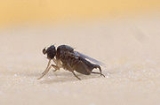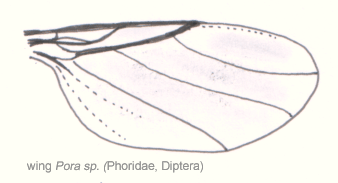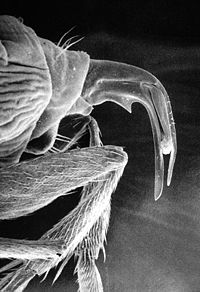
Phorid fly
Encyclopedia
Phoridae is a family
of small, hump-backed flies
resembling fruit flies
. Phorid flies can often be identified by their escape habit of running rapidly across a surface rather than taking to the wing. This behaviour is a source of one of their alternate names: scuttle fly. They are a diverse and successful group of insects. Approximately 4,000 species are known in 230 genera. The most well-known species is Megaselia scalaris
, commonly called a "coffin fly".
 Phorid flies are about – in (½–6 mm) in length. When viewed from the side, there is a pronounced hump to the thorax
Phorid flies are about – in (½–6 mm) in length. When viewed from the side, there is a pronounced hump to the thorax
.http://www.amonline.net.au/factsheets/images/gallery/large/coffin_fly.jpg The colour ranges from black or brown to yellowish.They have a characteristic wing venation.
Also in 1992, Brown presented a revised, cladistic classification based on many new character states. This classification included subfamilies Hypocerinae, Phorinae, Aenigmatiinae, Conicerinae, and Metopininae (Termitoxeniinae and Thaumatoxeninae were not included in his study). Disney rejected the entirety of Brown's work, deeming it premature, and a lively debate ensued Further resolution of this controversy awaits new data.
. They are frequently found around flowers and moist decaying matter, although they can be found throughout the house. Several species have the common name of the coffin fly, because they breed in human corpses with such tenacity that they can even continue their life cycle within buried coffins. For this reason they are important in forensic entomology
. More generally, the larvae breed in a numerous variety of locations, such as dung
, fungi, decaying plant matter or drain pipes. Most commonly they feed on decaying organic matter. Because they frequent unsanitary places they may transport various disease-causing organisms to food material.
, and via larva
l, and pupa
l stages before emerging as an adult. The female lays from 1 to 100 tiny eggs at a time in or on the larval food. She can lay up to 750 eggs in her lifetime. The time it takes from egg to adult varies on the species, but the average is about 25 days.
The larvae emerge in 24 hours and feed for a period of between 8 and 16 days, before crawling to a drier spot to pupate. The phorid fly's egg-to-adult life cycle can be as short as 14 days but may take up to 37 days.
Many species of phorid fly are specialist parasitoids of ants, but there are also species in the tropics that are parasitoids of stingless bees. These affected bees are often host to more than one fly larva and some individuals have been found to contain 12 phorid larva.
 Phorid flies also represent a new and hopeful means by which to control fire ant
Phorid flies also represent a new and hopeful means by which to control fire ant
populations in the southern United States
, where fire ants were accidentally introduced in the 1930s. The genus Pseudacteon, or ant-decapitating fly, of which 110 species have been documented, is a parasitoid
of the ant in South America
. Members of Pseudacteon reproduce by laying eggs in the thorax of the ant. The first instar
larvae migrate to the head. The larva
e develop by feeding on the hemolymph, muscle tissue, and nervous tissue in the head. Eventually, the larvae completely devour the ant's brain, causing it to do nothing but wander aimlessly for approximately two weeks. After about two to four weeks, they cause the ant's head to fall off by releasing an enzyme that dissolves the membrane attaching the ant's head to its body. The fly pupates in the detached head capsule, requiring a further two weeks before emerging. Various species of Phoridae have been introduced throughout the U. S. Southeast, starting with Travis, Brazos
, and Dallas
counties in Texas
, as well as Mobile, Alabama
, where the ants first entered North America.
Phoridae 672 Seiten, 437 Abbildungen, 15 Tafeln, 26x19cm
(in Erwin Lindner
: Die Fliegen der Paläarktischen Region, Band IV / 7 Teil 1)1981 ISBN 3-510-43023-9
Borgmeier, T. 1963. Revision of the North American phorid flies. Part I. The Phorinae, Aenigmatiinae, and Metopininae, except Megaselia (Diptera: Phoridae). Stud. Entomol. 6:1-256.Keys subfamilies, genera and species.
Family (biology)
In biological classification, family is* a taxonomic rank. Other well-known ranks are life, domain, kingdom, phylum, class, order, genus, and species, with family fitting between order and genus. As for the other well-known ranks, there is the option of an immediately lower rank, indicated by the...
of small, hump-backed flies
Fließ
Fließ is a municipality in the Landeck district and is located5 km south of Landeck on the upper course of the Inn River. It has 9 hamlets and was already populated at the roman age; the village itself was founded around the 6th century. After a conflagration in 1933 Fließ was restored more...
resembling fruit flies
Drosophila melanogaster
Drosophila melanogaster is a species of Diptera, or the order of flies, in the family Drosophilidae. The species is known generally as the common fruit fly or vinegar fly. Starting from Charles W...
. Phorid flies can often be identified by their escape habit of running rapidly across a surface rather than taking to the wing. This behaviour is a source of one of their alternate names: scuttle fly. They are a diverse and successful group of insects. Approximately 4,000 species are known in 230 genera. The most well-known species is Megaselia scalaris
Megaselia scalaris
The fly Megaselia scalaris is a member of the order Diptera and the family Phoridae. The family members are commonly known as the "humpbacked fly", the "coffin fly", and the "scuttle fly". The name "scuttle fly" derives from the jerky, short bursts of running, characteristic to the adult fly...
, commonly called a "coffin fly".
Appearance

Thorax (insect anatomy)
The thorax is the mid section of the insect body. It holds the head, legs, wings and abdomen. It is also called mesosoma in other arthropods....
.http://www.amonline.net.au/factsheets/images/gallery/large/coffin_fly.jpg The colour ranges from black or brown to yellowish.They have a characteristic wing venation.
Classification
Traditionally, phorids were classified into six subfamilies: Phorinae, Aenigmatiinae, Metopininae (including tribes Beckerinini and Metopinini), Alamirinae, Termitoxeniinae, and Thaumatoxeninae. Disney & Cumming (1992 ) abolished Alamirinae when they showed that they were the 'missing' males of Termitoxeniinae, which were known only from females.Also in 1992, Brown presented a revised, cladistic classification based on many new character states. This classification included subfamilies Hypocerinae, Phorinae, Aenigmatiinae, Conicerinae, and Metopininae (Termitoxeniinae and Thaumatoxeninae were not included in his study). Disney rejected the entirety of Brown's work, deeming it premature, and a lively debate ensued Further resolution of this controversy awaits new data.
Environment
Phorid flies are found worldwide, though the greatest variety of species is to be found in the tropicsTropics
The tropics is a region of the Earth surrounding the Equator. It is limited in latitude by the Tropic of Cancer in the northern hemisphere at approximately N and the Tropic of Capricorn in the southern hemisphere at S; these latitudes correspond to the axial tilt of the Earth...
. They are frequently found around flowers and moist decaying matter, although they can be found throughout the house. Several species have the common name of the coffin fly, because they breed in human corpses with such tenacity that they can even continue their life cycle within buried coffins. For this reason they are important in forensic entomology
Forensic entomology
Forensic entomology is the application and study of insect and other arthropod biology to criminal matters. It is primarily associated with death investigations; however, it may also be used to detect drugs and poisons, determine the location of an incident, and find the presence and time of the...
. More generally, the larvae breed in a numerous variety of locations, such as dung
Feces
Feces, faeces, or fæces is a waste product from an animal's digestive tract expelled through the anus or cloaca during defecation.-Etymology:...
, fungi, decaying plant matter or drain pipes. Most commonly they feed on decaying organic matter. Because they frequent unsanitary places they may transport various disease-causing organisms to food material.
Life cycle
Phorid flies develop from an eggEgg (biology)
An egg is an organic vessel in which an embryo first begins to develop. In most birds, reptiles, insects, molluscs, fish, and monotremes, an egg is the zygote, resulting from fertilization of the ovum, which is expelled from the body and permitted to develop outside the body until the developing...
, and via larva
Larva
A larva is a distinct juvenile form many animals undergo before metamorphosis into adults. Animals with indirect development such as insects, amphibians, or cnidarians typically have a larval phase of their life cycle...
l, and pupa
Pupa
A pupa is the life stage of some insects undergoing transformation. The pupal stage is found only in holometabolous insects, those that undergo a complete metamorphosis, going through four life stages; embryo, larva, pupa and imago...
l stages before emerging as an adult. The female lays from 1 to 100 tiny eggs at a time in or on the larval food. She can lay up to 750 eggs in her lifetime. The time it takes from egg to adult varies on the species, but the average is about 25 days.
The larvae emerge in 24 hours and feed for a period of between 8 and 16 days, before crawling to a drier spot to pupate. The phorid fly's egg-to-adult life cycle can be as short as 14 days but may take up to 37 days.
Many species of phorid fly are specialist parasitoids of ants, but there are also species in the tropics that are parasitoids of stingless bees. These affected bees are often host to more than one fly larva and some individuals have been found to contain 12 phorid larva.
Control of fire ants

Red imported fire ant
See main article Fire ant.The red imported fire ant , or simply RIFA, is one of over 280 species in the widespread genus Solenopsis...
populations in the southern United States
United States
The United States of America is a federal constitutional republic comprising fifty states and a federal district...
, where fire ants were accidentally introduced in the 1930s. The genus Pseudacteon, or ant-decapitating fly, of which 110 species have been documented, is a parasitoid
Parasitoid
A parasitoid is an organism that spends a significant portion of its life history attached to or within a single host organism in a relationship that is in essence parasitic; unlike a true parasite, however, it ultimately sterilises or kills, and sometimes consumes, the host...
of the ant in South America
South America
South America is a continent situated in the Western Hemisphere, mostly in the Southern Hemisphere, with a relatively small portion in the Northern Hemisphere. The continent is also considered a subcontinent of the Americas. It is bordered on the west by the Pacific Ocean and on the north and east...
. Members of Pseudacteon reproduce by laying eggs in the thorax of the ant. The first instar
Instar
An instar is a developmental stage of arthropods, such as insects, between each molt , until sexual maturity is reached. Arthropods must shed the exoskeleton in order to grow or assume a new form. Differences between instars can often be seen in altered body proportions, colors, patterns, or...
larvae migrate to the head. The larva
Larva
A larva is a distinct juvenile form many animals undergo before metamorphosis into adults. Animals with indirect development such as insects, amphibians, or cnidarians typically have a larval phase of their life cycle...
e develop by feeding on the hemolymph, muscle tissue, and nervous tissue in the head. Eventually, the larvae completely devour the ant's brain, causing it to do nothing but wander aimlessly for approximately two weeks. After about two to four weeks, they cause the ant's head to fall off by releasing an enzyme that dissolves the membrane attaching the ant's head to its body. The fly pupates in the detached head capsule, requiring a further two weeks before emerging. Various species of Phoridae have been introduced throughout the U. S. Southeast, starting with Travis, Brazos
Brazos County, Texas
Brazos County is a county located in the U.S. state of Texas in the Central Texas region. In 2010, its population was 194,851. The county seat is Bryan and it is part of the Bryan-College Station metropolitan area. Brazos is named for the Brazos River, along with Brazoria...
, and Dallas
Dallas County, Texas
As of the census of 2000, there were 2,218,899 people, 807,621 households, and 533,837 families residing in the county. The population density was 2,523 people per square mile . There were 854,119 housing units at an average density of 971/sq mi...
counties in Texas
Texas
Texas is the second largest U.S. state by both area and population, and the largest state by area in the contiguous United States.The name, based on the Caddo word "Tejas" meaning "friends" or "allies", was applied by the Spanish to the Caddo themselves and to the region of their settlement in...
, as well as Mobile, Alabama
Mobile, Alabama
Mobile is the third most populous city in the Southern US state of Alabama and is the county seat of Mobile County. It is located on the Mobile River and the central Gulf Coast of the United States. The population within the city limits was 195,111 during the 2010 census. It is the largest...
, where the ants first entered North America.
Identification
Beyer, E.; Delage, A. Bearbeitet von: Schmitz, H.Hermann Schmitz
Hermann Schmitz was a German entomologist who specialised in Hymenoptera and Diptera.Schmitz was a priest in Valkenburg. He is best known for his studies of Phoridae...
Phoridae 672 Seiten, 437 Abbildungen, 15 Tafeln, 26x19cm
(in Erwin Lindner
Erwin Lindner
Erwin Lindner was a German entomologist mainly interested in Diptera.He was born in Böglins, Memmingen , 7 April 1888 and died in Stuttgart 30 November 1988, aged 100 years....
: Die Fliegen der Paläarktischen Region, Band IV / 7 Teil 1)1981 ISBN 3-510-43023-9
Borgmeier, T. 1963. Revision of the North American phorid flies. Part I. The Phorinae, Aenigmatiinae, and Metopininae, except Megaselia (Diptera: Phoridae). Stud. Entomol. 6:1-256.Keys subfamilies, genera and species.
External links
- Entomology Section, Natural History Museum of Los Angeles County
- Family description and images
- Gallery from Diptera.info
- Taxonomy and ecofaunistic... In German (parts in English) Excellent illustrations.
- Pseudacteon species used in fire ant control on the UFUniversity of FloridaThe University of Florida is an American public land-grant, sea-grant, and space-grant research university located on a campus in Gainesville, Florida. The university traces its historical origins to 1853, and has operated continuously on its present Gainesville campus since September 1906...
/ IFASInstitute of Food and Agricultural SciencesThe University of Florida’s Institute of Food and Agricultural Sciences is a federal-state-county partnership dedicated to developing knowledge in agriculture, human and natural resources, and the life sciences, and enhancing and sustaining the quality of human life by making that information...
Featured Creatures Web site - A discovery channel short, covering these flies

